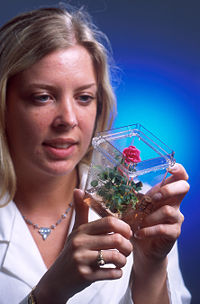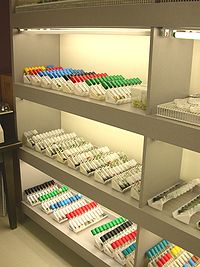- Micropropagation
-
Micropropagation is the practice of rapidly multiplying stock plant material to produce a large number of progeny plants, using modern plant tissue culture methods.[1]
Micropropagation is used to multiply novel plants, such as those that have been genetically modified or bred through conventional plant breeding methods. It is also used to provide a sufficient number of plantlets for planting from a stock plant which does not produce seeds, or does not respond well to vegetative reproduction.
Contents
Methods
Establishment
Micropropagation begins with the selection of plant material to be propagated. Clean stock materials that are free of viruses and fungi are important in the production of the healthiest plants. Once the plant material is chosen for culture, the collection of explant(s) begins and is dependent on the type of tissue to be used; including stem tips, anthers, petals, pollen and others plant tissues. The explant material is then surface sterilized, usually in multiple courses of bleach and alcohol washes and finally rinsed in sterilized water. This small portion of plant tissue, sometimes only a single cell, is placed on a growth medium, typically containing sucrose as an energy source and one or more plant growth regulators (plant hormones). Usually the medium is thickened with agar to create a gel which supports the explant during growth. Some plants are easily grown on simple media but others require more complicated media for successful growth; The plant tissue grows and differentiates into new tissues depending on the medium. For example, media containing cytokinins are used to create branched shoots from plant buds. and it happens in a vegetative form
Multiplication
Multiplication is the taking of tissue samples produced during the first stage and increasing their number. Following the successful introduction and growth of plant tissue, the establishment stage is followed by multiplication. Through repeated cycles of this process, a single explant sample may be increased from one to hundreds or thousands of plants. Depending on the type of tissue grown, multiplication can involve different methods and media. If the plant material grown is callus tissue, it can be placed in a blender and cut into smaller pieces and recultured on the same type of culture medium to grow more callus tissue. If the tissue is grown as small plants called plantlets, hormones are often added that cause the plantlets to produce many small offshoots that can be removed and recultured.these are all 5 types
Pretransplant
 Banana plantlets transferred to soil (with vermicompost) from plant media. This process is done for acclimatization of plantlets to the soil as they were previously grown in plant media. After growing for some days the plantlets are transferred to the field.
Banana plantlets transferred to soil (with vermicompost) from plant media. This process is done for acclimatization of plantlets to the soil as they were previously grown in plant media. After growing for some days the plantlets are transferred to the field.
This stage involves treating the plantlets/shoots produced to encourage root growth and "hardening." It is performed in vitro, or in a sterile "test tube" environment.
"Hardening" refers to the preparation of the plants for a natural growth environment. Until this stage, the plantlets have been grown in "ideal" conditions, designed to encourage rapid growth. Due to lack of necessity, the plants are likely to be highly susceptible to disease and often do not have fully functional dermal coverings and will be inefficient in their use of water and energy. In vitro conditions are high in humidity and plants grown under these condition do not form a working cuticle and stomata that keep the plant from drying out, when taken out of culture the plantlets need time to adjust to more natural environmental conditions. Hardening typically involves slowly weaning the plantlets from a high-humidity, low light, warm environment to what would be considered a normal growth environment for the species in question. This is done by moving the plants to a location high in humidity,
Transfer from culture
In the final stage of plant micropropagation, the plantlets are removed from the plant media and transferred to soil or (more commonly) potting compost for continued growth by conventional methods.
This stage is often combined with the "pretransplant" stage.
Advantages
Micropropagation has a number of advantages over traditional plant propagation techniques:
- The main advantage of micropropagation is the production of many plants that are clones of each other.
- Micropropagation can be used to produce disease-free plants.
- Micropropagation produces rooted plantlets ready for growth, saving time for the grower when seeds or cuttings are slow to establish or grow.
- It can have an extraordinarily high fecundity rate, producing thousands of propagules while conventional techniques might only produce a fraction of this a number.
- It is the only viable method of regenerating genetically modified cells or cells after protoplast fusion.
- It is useful in multiplying plants which produce seeds in uneconomical amounts, or when plants are sterile and do not produce viable seeds or when seed can't be stored (vgr. recalcitrant seeds).
- Micropropagation often produces more robust plants, leading to accelerated growth compared to similar plants produced by conventional methods - like seeds or cuttings.
- Some plants with very small seeds, including most orchids, are most reliably grown from seed in sterile culture.
- A greater number of plants can be produced per square meter and the propagules can be stored longer and in a smaller area.
Disadvantages
Micropropagation is not always the perfect means of multiplying plants. Conditions that limits its use include:
- It is very expensive, and can have a labor cost of more than 70%
- A monoculture is produced after micropropagation, leading to a lack of overall disease resilience, as all progeny plants may be vulnerable to the same infections.
- An infected plant sample can produce infected progeny. This is uncommon if the stock plants are carefully screened and vetted to prevent culturing plants infected with virus or fungus.
- Not all plants can be successfully tissue cultured, often because the proper medium for growth is not known or the plants produce secondary metabolic chemicals that stunt or kill the explant.
- Sometimes plants or cultivars do not come true to type after being tissue cultured. This is often dependent on the type of explant material utilized during the initiation phase or the result of the age of the cell or propagule line.
- Some plants are very difficult to disinfest of fungal organisms.
The major limitation in the use of micropropagation for many plants is the cost of production; for many plants the use of seeds, which are normally disease free and produced in good numbers, readily produce plants (see orthodox seed) in good numbers at a lower cost. For this reason, many plant breeders do not utilize micropropagation because the cost is prohibitive. Other breeders use it to produce stock plants that are then used for seed multiplication.Mechanisation of the process could reduce labour costs, but has proven difficult to achieve, despite active attempts to develop technological solutions.
References
Notes
- ^ "Micropropagation - Definitions from Dictionary.com". dictionary.reference.com. http://dictionary.reference.com/browse/Micropropagation. Retrieved 2008-03-17.
Bibliography
External links
Categories:- Agronomy
- Horticulture and gardening
- Plant reproduction
Wikimedia Foundation. 2010.


